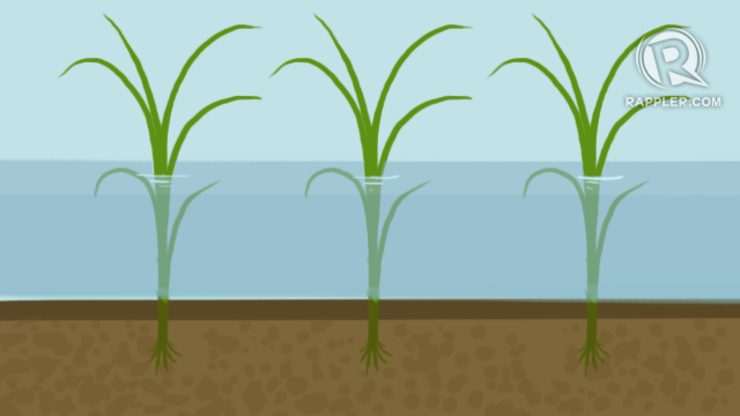SUMMARY
This is AI generated summarization, which may have errors. For context, always refer to the full article.

LOS BAÑOS, Philippines – Can you imagine a world without rice?
If climate change has its way, that may be the kind of world that awaits us, or at the very least, our children.
Rice, with its dependence on water and sensitivity to heat, is one of many crops threatened by global warming. In the Philippines, every 1 degree Celsius increase in night-time temperature could reduce the amount of harvested rice by as much as 10%, according to the Department of Agriculture.
Rice, which feeds almost half of the human population, is already suffering from other impacts of the global phenomenon such as rising sea levels, drought and stronger typhoons. (READ: How gov’t is readying farmers for climate change)
Add this to the fact that by 2050, the world will have to feed an estimated 2 billion more people. With more mouths to feed, limited land to grow rice and climate change, the world is looking bleak for rice-lovers.
That’s why scientists all over the world are coming up with new types of rice that can withstand the worst of climate change and still end up in people’s plates.
Here are new kinds of rice developed by the International Rice Research Institute (IRRI) in Los Baños, Laguna using advanced breeding technology.
Flood-tolerant rice
Typhoon-prone Philippines loses millions of tons of rice each year due to flooding. Global warming could mean stronger typhoons and possibly more frequent flooding. Rice plants typically die within 4 days of being submerged in flood waters. But not rice with a special gene called SUB1.
Rice varieties with this gene are able to thrive after being submerged for 10 to 15 days, according to IRRI.
IRRI has so far developed 3 varieties: IRRI 156 or NSIC Rc238 (known to farmers as Tubigan 21), IRRI 154 or NSIC Rc222 (Tubigan 18) and IRRI 168 or NSIC Rc302 (Tubigan 25).
Depending on the variety, farmers may be able to harvest 5.7 tons per hectare to 10.6 tons per hectare when they are normally only able to harvest around 3 tons per hectare.
Drought-tolerant rice

The Philippines may experience El Niño starting December. Climate change is expected to cause more severe droughts. As summers get hotter and drier, what should be the most productive time of the year for rice farmers could become a time of scarcity.
According to IRRI, drought can affect 23 million hectares of rainfed rice in South and Southeast Asia alone, making it the most widespread and damaging of all environmental stresses.
The sahod ulan varieties developed by IRRI are able to survive drought conditions, generating a yield of 2.4 tons per hectare to 6.7 tons per hectare depending on the variety and farming conditions.
There are 5 varieties in all: IRRI 164 or NSIC Rc284 (Sahod Ulan 8), IRRI 163 or NSIC Rc280 (Sahod Ulan 6), IRRI 162 or NSIC Rc278 (Sahod Ulan 5), IRRI 161 or NSIC Rc274 (Sahod Ulan 3) and IRRI 148 or NSIC Rc192 (Sahod Ulan 1).
Saline-tolerant rice

Rice paddies near the sea are in big trouble according to climate change predictions. Ice melting in other parts of the world could lead to sea levels rising by a centimeter each year.
Storm surge, an effect of monstrous typhoons, could also bring in saltwater – typically deadly for rice – into inland rice paddies.
Saltwater receding into the sea usually do so by way of rivers which rice farmers use to irrigate their fields.
“They don’t know it’s already salty so even before detecting it, their plants are already dying. These are the real terrorists in our area,” said IRRI senior scientist Glenn Gregorio.
IRRI has 15 varieties of rice that can survive in the presence of salt, he said. These include IRRI 173 or NSIC Rc340 (Salinas 18), IRRI 172 or NSIC Rc336 (Salinas 16) and IRRI 165 or NSIC Rc296 (Salinas 9).
These varieties can have yields of between 2.4 tons per hectare to 3.9 tons per hectare depending on variety.
These climate-smart rice varieties are already available in the market. But Gregorio estimates that only around 10% of Filipino farmers are using them.
Farmers can get these varieties by contacting the Philippine Rice Institute (PhilRice) and regional offices of the Department of Agriculture. They may also contact IRRI by calling (632) 580-5600, (6349) 536-2701 or emailing info@irri.org. – Rappler.com
Farmer plant rice image from Shutterstock
Add a comment
How does this make you feel?
There are no comments yet. Add your comment to start the conversation.